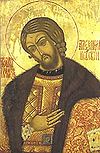- Nestor Kukolnik
-
 Nestor Kukolnik - portrait by Karl Briullov.
Nestor Kukolnik - portrait by Karl Briullov.
Nestor Vasilievich Kukolnik (Russian: Нестор Васильевич Кукольник) (1809–1868) was a Russian playwright and prose writer of Carpatho-Rusyn origin. Immensely popular during the early part of his career, his works were subsequently dismissed as sententious and sentimental. Today, he is best remembered for having contributed to the libretto of the first Russian opera, A Life for the Tsar by Mikhail Glinka. Glinka also set many of his lyrics to music.
Contents
Family background
Nestor Kukolnik was born on September 8, 1809 in the city of Saint Petersburg in the family of a professor lecturing at the Saint Petersburg Teacher's College. His father, Bazyli Wojciech Kukolnik belonged to the ethnic group of Rusyns (Ruthenians) and came from an old noble family. Graduate of Vienna University, he lectured at Poland. In 1804, Bazyli Wojciech Kukolnik was invited to teach in Russia along with professors Ivan Orlay (Orlay János) and Mikhail Balugjanskij. Among his pupils were Grand Duke Constantine Pavlovich of Russia and Grand Duke Nikolai Pavlovich of Russia, the future emperor Nikolai I of Russia; Czar Alexander I of Russia granted Vasily Kukolnik an estate in the Vilno Oblast and was Nestor Kukolnik's godfather at his baptism.
Early life and studies
Nestor studied at the Nizhyn Gymnasium of Higher Sciences (present-day Ukraine), founded earlier by Nestor’s father. Nikolai Gogol studied at the same institution and they both played at the school theater. Kukolnik’s literature activity started in gymnasium, where he wrote his first verses and dramas. After graduating from Nizhyn Gymnasium in 1829, he gave lessons at Vilna (present-day Vilnius, Lithuania) Gymnasium, and in 1831 moved with his brother Platon Kukolnik to Saint Petersburg, where he served at the Ministry of Finance.
Literary activity
In 1833 Kukolnik’s first play “Tortini” was published by Faddei Bulgarin, soon followed by fantasy drama “Torcuato Tasso”, which resulted in his reputation as a legendary playwright in the capital. The turning point in his literary career came in 1834, after demonstration of patriotic drama "Ruka Vsevishnego Otechestvo Spasla" (The God’s Hand Saved The Motherland), applauded by the Russian Emperor Nicolas I at the play’s premiere. Inspired by this success, the writer produces historical play “Prince Mikhail Vasilievich Skopin-Shuysky”. In 1836 he founded The Gazette of Fine Arts (Khudozhestvennaia gazeta) which was published in Saint Petersburg until 1842 and wrote more than two hundred articles on art.
Kukolnik's oeuvre is diverse. He experimented with multiple genres and formats: novels, historical tales, criticism, poetry and even music. He was a friend of Mikhail Glinka, who to set some of Kukolnik's verses (Hesitation, Skylark, and Passing Song, among others) to music. Dizzy from his success, he proclaimed that there were only three geniuses in Russia - himself as a writer, Mikhail Glinka as a composer, and Karl Briullov as a painter.
Resignation and later life in Taganrog
In 1857 Nestor Kukolnik resigned and settled in Taganrog. There he continued his literaty activity, but the public work played the key role of his life in that period. Nestor Vasilievich did a lot of work for education of Taganrog's society. It had an influence on the destiny of the city, making it into the centre of education in the South of Russia.
Nestor Kukolnik was the first to prove the need of university education in the Don Voisko Province and on Azov Sea. His offer to open a university in Taganrog was not successful, but later it proved to be an important foundation for opening the Novorossiya University in Odessa (1865). Kukolnik also proved necessity of local newspapers. It was one of the reasons to open newspaper-publishing houses not only in Taganrog, but also in Odessa and Rostov on Don. Since 1865 Nestor Kukolnik led the workgroup that proved necessity of a railroad line from Kharkov to Taganrog. This work was a success and the Tsar Alexander II of Russia approved the project in 1868. He also was the first to raise the issue of environmental protection of the Gulf of Taganrog. But the related project encountered strong resistance from regional leadership and was not realized. Nestor Vasilievich assisted in opening the county court in Taganrog, open soon after his death in 1869.
Kukolnik died unexpectedly in Taganrog in December 1868.
In 2008 within the framework of the writer's 200th birth anniversary, one of the streets in Taganrog was named after Kukolnik[1].
 Residence of Nestor Kukolnik in Taganrog © TaganrogCity.Com
Residence of Nestor Kukolnik in Taganrog © TaganrogCity.Com
.
 Memorial plate on Nestor Kukolnik's residence in Taganrog. © TaganrogCity.Com
Memorial plate on Nestor Kukolnik's residence in Taganrog. © TaganrogCity.Com
External links and references
- ^ Решение Городской Думы города Таганрога №560 от 29.11.2007
People from Russia Leaders and religious - Pre-1168
- 1168–1917
- 1922–1991
- 1991–present
- RSFSR leaders
- General secretaries
- Soviet premiers (1st deputies)
- Soviet heads of state (and their spouses)
- Prime ministers (1st deputies)
- Foreign ministers
- Prosecutors general
- Metropolitans and patriarchs
- Saints

Military and explorers - Field marshals
- Soviet marshals
- Admirals
- Aviators
- Cosmonauts
Scientists and inventors - Aerospace engineers
- Astronomers and astrophysicists
- Biologists
- Chemists
- Earth scientists
- Electrical engineers
- IT developers
- Linguists and philologists
- Mathematicians
- Naval engineers
- Physicians and psychologists
- Physicists
- Weaponry makers
Artists and writers Sportspeople Chess playersCategories:- 1809 births
- 1868 deaths
- People from Saint Petersburg
- Russian opera librettists
- Russian dramatists and playwrights
- Russian poets
- Russian nobility
Wikimedia Foundation. 2010.
